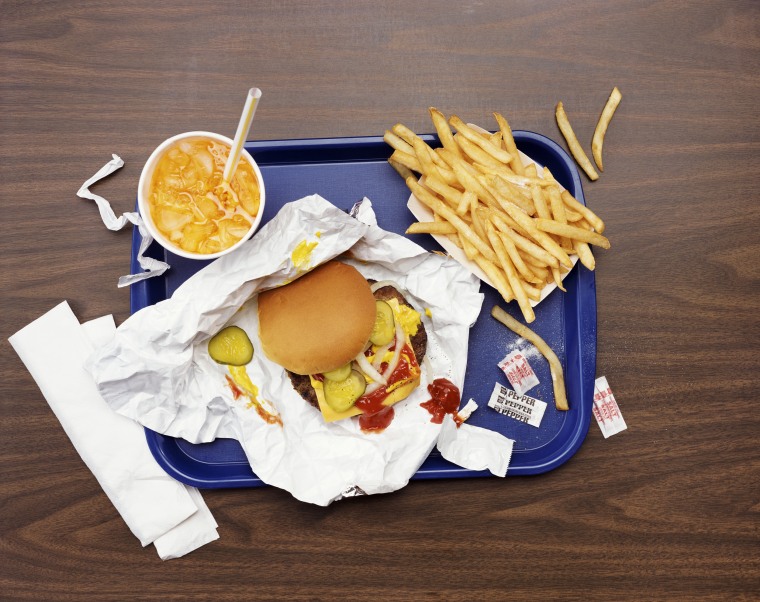Blame your biology for your fast food habit. New research suggests that your brain is hard-wired to crave foods that combine fat and carbohydrates, such as the fries and shakes that beckon from the drive-thru menu. Foods like these, rich in both macronutrients, send strong signals to your brain’s reward system, priming you to overeat. In other words, the combo order of fries, a shake and a burger may seem irresistible.
This jives with results of a study published last year among more than 8,000 adults, almost 80 percent of whom reported eating fast food at least once a week. Even when considering different income brackets, fast-food-eating didn’t change much. And when income levels went up or down, say due to changes in employment, fast food habits stayed the same. The latest results suggest our brain circuitry might be prompting our fast food routines.
Though it may seem like the odds are stacked against you, there are a few hacks that can make your fast food habit a bit healthier. Here are six tips to try.
The Don’ts:
- Forget the phrase SUPERSIZE. Don’t double up on burgers, upsize your fries or buy in to a giant caloric beverage. Just don’t. Forget the combo orders, too. I’m all for a bargain but believe me, you’ll want to spare yourself the excess sodium, artery-clogging saturated fat, sugar and calories. Alone, each of these things can raise your risk of chronic illness; together, well, let’s just call this a bad mix.
- Please pass on the sugary drinks. Even small soda once a week adds up to 7,800 calories over the course of a year. It may not sound like a ton, but it could be the difference between maintaining your weight and ultimately asking yourself, “when did I gain 5 pounds?” In fact, if you’re regularly consuming soda outside of your fast food fix, you should reconsider that, too. If your workplace has a water cooler, you can fill up for free. Make it your beverage of choice.
The Do’s
- Prioritize produce. I get it, you’re there for the combo burger and fries, but if this is a weekly pit stop, pick the salad 75 percent of the time. The point is, once you’re doing something on a routine basis, it can’t be considered a treat. From Taco Bell to Wendy’s and everywhere else, salads are part of the main menu so make a plant-forward pick most of the time.
- Repeat the phrase, “I’ll have the single.” Though I don’t consider a fast food burger a nutritional powerhouse, a single burger has sufficient protein to fill you up and isn’t a total calorie bomb. Sure, I’d prefer to see a whole grain bun (fast food chains: Are you listening?), but the small amount of white bread every once in a while won’t do you in. If a single burger sounds too skimpy, steer yourself toward the sides and kids’ menus to look for fruits and veggies. You’ll often find a small salad, a fruit cup or even a whole piece of fruit.
- Go easy on the fries. I know I’m asking a lot, but hear me out. Even a small order, with nearly as many calories as the burger and all those starchy carbs, won’t do your body any favors. If you can’t live without them, share them with a co-worker. But it’s a good idea to skip the side order most of the time.
- Read food labels. What does this have to do with eating fast food? It turns out that label readers ate fast food less often. “While I don’t know for sure, my belief is that individuals who care enough to check the ingredients of items before eating them are trying to eat healthier and looking to avoid less healthy options that dominate the menu of fast food restaurants,” shares co-author Jay Zagorsky, research scientist at the Center for Human Resource Research at The Ohio State University.
Even small soda once a week adds up to 7,800 calories over the course of a year.
Priming yourself to read labels is a step towards understanding how to eat more healthfully and shop for more nutritious fare. Perhaps then, it’ll be easier to pass by the drive-through and stick with a convenient supermarket pick, such as a pre-packaged salad mix or a veggie-centric frozen meal.
MORE TIPS AND TRICKS FROM A NUTRITIONIST
- The healthiest things to eat at Panera Bread
- How to build a better smoothie
- Healthy Trader Joe's products nutritionists swear by
- 11 delicious avocado recipes that don't involve avocado toast
- Seriously filling salads you'll want to eat all summer
Want more tips like these? NBC News BETTER is obsessed with finding easier, healthier and smarter ways to live. Sign up for our newsletter and follow us on Facebook, Twitter and Instagram.

